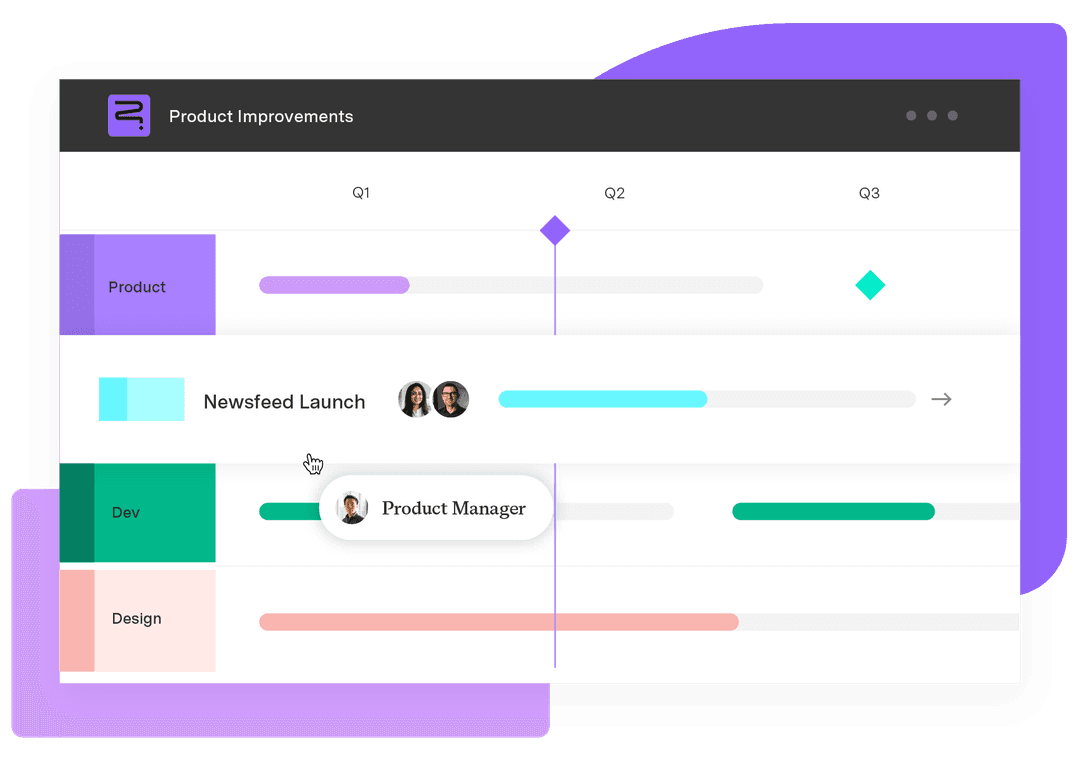Using feasibility analysis to validate your next move
Tempo Team
Before investing time, money, and energy into a new project, leaders must evaluate its viability. A feasibility analysis helps identify whether the proposed initiative is technically, financially, and operationally practical within the given constraints. This critical evaluation process gives decision-makers the insights to proceed confidently – or reconsider their plans before making significant investments.
In this guide, we’ll explore the key components of feasibility analysis and offer guidance on how to effectively assess a project’s chances of success.
What is a feasibility study?
A feasibility study analyzes whether a proposed project is realistic, cost-effective, and worth pursuing. It examines every essential factor, from technical requirements to potential roadblocks, so team members and stakeholders can make informed decisions early.
Before committing resources, project teams must understand the whole picture – what it will take to make the idea work and whether it fits the organization’s broader goals. A feasibility study helps assess these questions by systematically evaluating factors such as:
Market demand
Resource availability
Cost projections
Potential risks
Conducting a feasibility study lays the groundwork for data-backed decisions, helping project managers reduce the risk of wasted resources and increase the chances of project success.
What are the primary purposes of a feasibility study?
Conducting a feasibility study highlights how a project might work, what could stand in the way, and whether it’s worth the investment. Here are six key objectives it serves:
Evaluate project viability in real-world conditions
The feasibility study examines whether the project is doable within the current environment, considering your team’s current capacity, available tools, and the market or operational conditions that could impact success. It asks you to pin down assumptions and examine whether they hold up under scrutiny.
Identify risks, limitations, and unknowns
Every project has blind spots. A feasibility study helps surface them before you’re too far along to pivot. Roadblocks might include legal barriers, compliance issues, staffing shortages, supply chain complications, or technical challenges that weren’t initially obvious.
Clarify scope and requirements
Another function of a feasibility study is to narrow the focus of vague or overly ambitious projects. What exactly needs to be delivered? What does success look like? What are the must-haves versus the nice-to-haves? Clarifying these points upfront helps teams avoid misaligned expectations later.
Build a case for stakeholder support
You’ll get backing from leadership and stakeholders more easily if you can present a thorough analysis of a project’s risks and benefits. A feasibility study provides the structured evidence decision-makers need to approve funding, allocate resources, or greenlight further planning.
Ensure alignment with business strategy
Even if a project is technically achievable, it may not be the right move. A feasibility study asks whether it serves the company’s mission and fits into long-term plans. For example, launching a new product may be exciting, but it could hurt more than help if it distracts from a core offering or stretches the team thin.
Support intelligent planning and execution
A feasibility study is useful even if the project is certain to be approved. It allows managers to create estimates for scheduling, budgeting, and resource planning so they can maximize efficiency.
Steps to conduct a feasibility study
A feasibility study needs structure. Leaders must ask the right questions in a logical order to create a precise assessment. Here’s a step-by-step process to guide your team:
1. Define the project scope and goals
Start by outlining what the project should achieve. What problem are you trying to solve? What opportunity do you want to pursue? Define what success looks like, who the stakeholders are, and what constraints already exist. This sets the boundaries for your feasibility study and helps focus the rest of the analysis.
2. Perform a preliminary analysis
Before diving deep, check the surface: Is the idea fundamentally realistic? This step filters out nonstarters. Look at similar projects you or others have attempted and scan available resources. If the project still looks promising, move on to a more thorough assessment.
3. Assess feasibility areas
This is the core of your feasibility study. Examine whether the project is feasible from multiple perspectives:
Technical feasibility: Do you have the tools, skills, and infrastructure?
Operational feasibility: Can your existing team realistically take this on?
Legal or regulatory feasibility: Will any permits, laws, or rules affect execution?
Market feasibility: Is there a demand for what you’re building? This step may involve market research, data analysis, and testing parts of the project with a proof of concept.
4. Analyze the costs and benefits
What will the project cost in terms of money, time, and people? Include hidden or long-term costs like training or system updates. Don’t forget about opportunity cost – the initiatives you won’t be able to pursue because of this project.
On the benefits side, look at both direct returns (e.g., revenue) and indirect ones (e.g., improved customer satisfaction). If the costs outweigh the benefits, the project may not be worth pursuing in its current form.
5. Assess potential risks
Every project carries risk, but not all risks are equal. Identify what could go wrong and how severe the impact would be. After listing risks, consider whether you can reasonably mitigate them. A project with a significant upside but unmanageable risk may still be a no-go.
6. Present and document findings
Once the analysis is complete, summarize your discoveries in a report. Back your recommendations with evidence and make them easy to understand. Include the project goals, the findings from each feasibility area, a cost-benefit analysis, and a final conclusion. Present the report to stakeholders and allow room for discussion and follow-up questions.
Feasibility study example
Let’s explore an example that demonstrates how feasibility studies work in practice.
Scenario: A mid-sized software company is considering launching a new SaaS product for freelance graphic designers. The product would offer browser-based design tools with built-in invoicing and file-sharing features.
The feasibility study looks like this:
Project scope and goals
The feasibility study defines the goal as creating a subscription-based tool that simplifies freelance designers’ day-to-day workflow. It identifies primary goals (e.g., product features and monthly user targets) and constraints (e.g., budget, development timeline, and internal staffing limits).
Preliminary analysis
Early market research suggests a growing demand for lightweight alternatives to bulky design suites. However, several strong competitors already exist. The team reviews similar launches for lessons and identifies potential gaps in the market.
Feasibility areas
Technical: The internal team has front-end skills but must contract a back-end developer.
Operational: The current staff bandwidth is tight. They propose hiring a part-time project manager.
Legal: Data storage and GDPR compliance need to be addressed to reach an EU user base.
Market: Survey responses from 120 freelancers show interest, but they expect affordable pricing.
Final assessment
The feasibility study concludes with a cost-benefit analysis to weigh projected expenses against potential returns, a risk assessment to identify obstacles and mitigation strategies, and a recommendation with defined conditions for moving forward. Together, these steps help decision-makers determine whether the project is worth pursuing and under what circumstances.
Feasibility study template
Use this outline to guide your feasibility study:
1. Project overview
Project name
Brief description
Objectives
Stakeholders
2. Scope and goals
What will the project deliver?
Key success criteria
Timeframe
Budget constraints
3. Preliminary analysis
Early research findings
Initial go/no-go indicators
Summary of similar past efforts
4. Feasibility evaluation
Technical feasibility
Operational feasibility
Legal/regulatory considerations
Market or customer demand
Resource availability
5. Cost-benefit analysis
Estimated costs (e.g., development, staffing, or materials)
Expected benefits (e.g., revenue, efficiency gains, or user satisfaction)
Break-even analysis
6. Risk assessment
List of potential risks
Likelihood and impact ratings
Proposed mitigation strategies
7. Conclusion and recommendation
Summary of findings
Recommendation: Proceed, revise, or halt?
Next steps if approved
Align feasibility studies with strategic execution in Tempo
A feasibility study is only helpful if it leads to informed action. Tempo’s Jira-enabled tools help teams translate their findings into project plans that support company goals.
Tempo’s Strategic Roadmaps allows teams to visualize timelines and prioritize efforts during project planning. This big-picture view helps align execution with the original objectives defined in the feasibility study. If a study uncovers risks, managers can incorporate those concerns into the roadmap and adjust as needed.
With Custom Charts for Jira, teams can monitor budget usage, sprint progress, and other critical success factors identified by the feasibility study. If the feasibility study highlights a cost-benefit tipping point or a return timeline, leaders can track those benchmarks in real time.
Together, Tempo’s tools ensure projects begin with careful assessment and stay on track throughout execution.












































